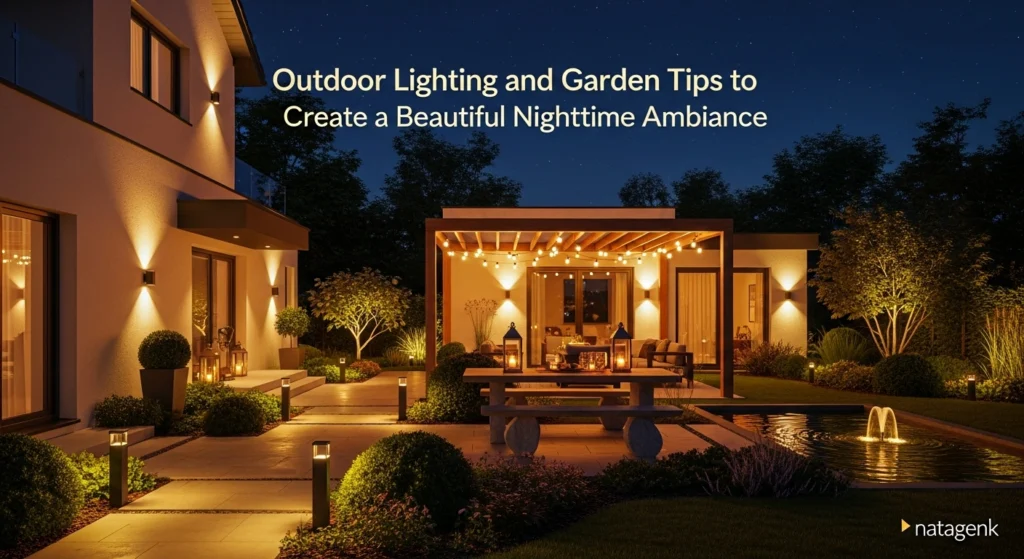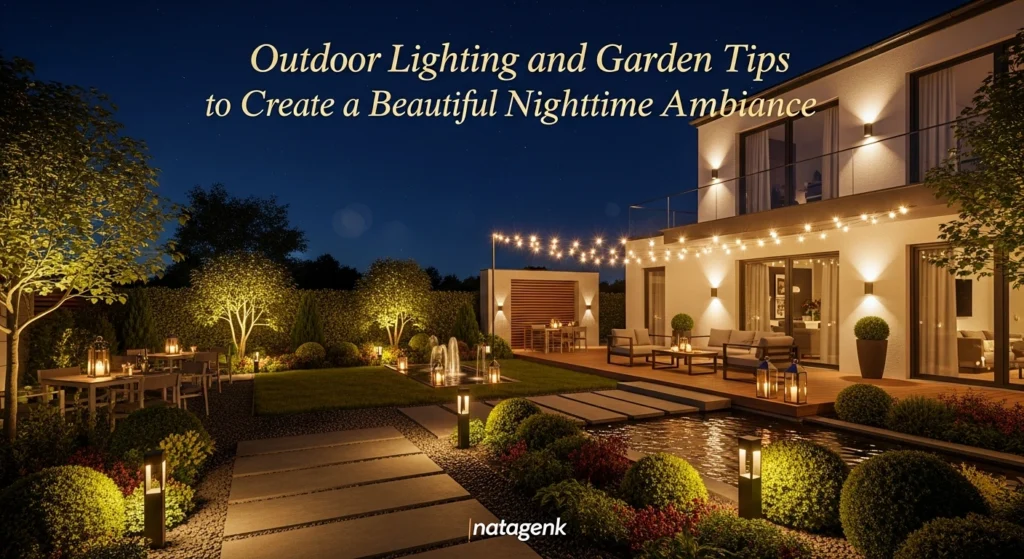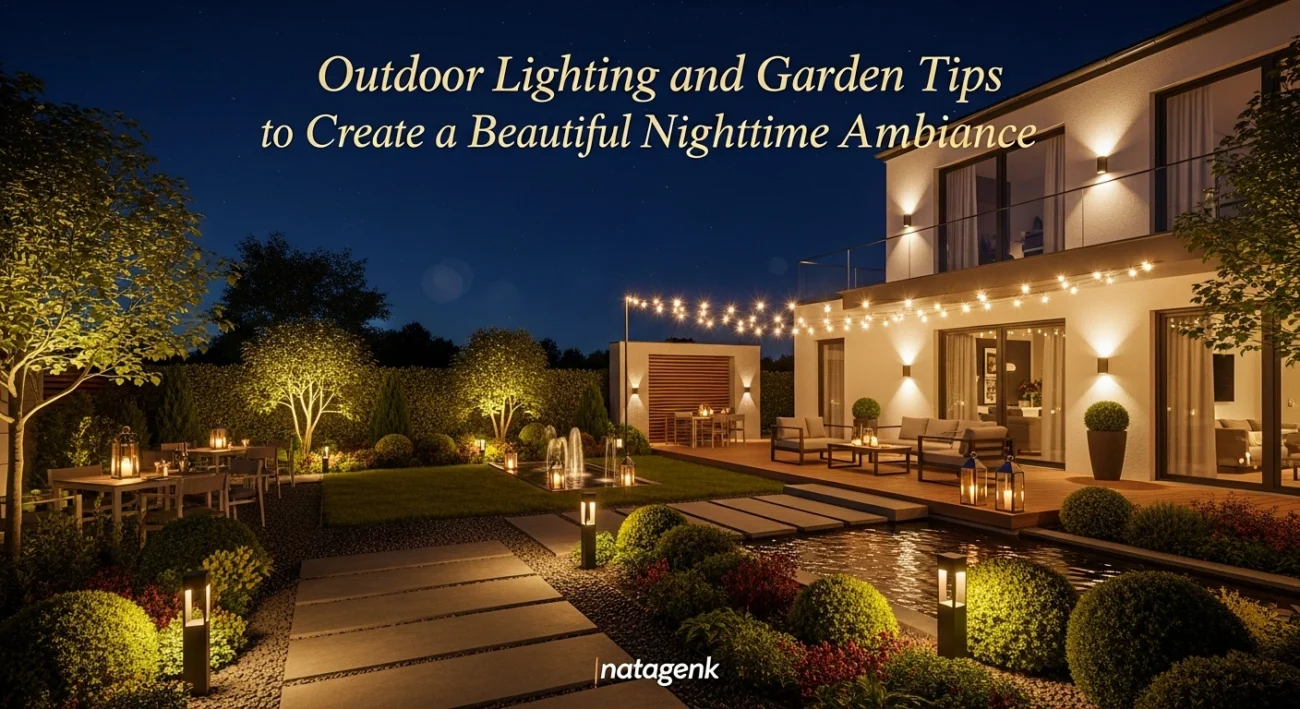Outdoor Lighting and Garden Tips to Create a Beautiful Nighttime Ambiance
Outdoor Lighting and Garden Tips to Create a Beautiful Nighttime Ambiance – An outdoor space is a true extension of your home, a place for relaxation, entertainment, and connection with nature. During the day, sunlight dictates its character, but as dusk falls, the garden can either recede into darkness or transform into a magical, enchanting realm. This transformation is entirely orchestrated by a well-thought-out lighting plan, turning overlooked corners into focal points and functional paths into beautiful, illuminated journeys.
The strategic use of light does more than just beautify; it enhances safety, security, and the overall usability of your property after sundown. A thoughtfully illuminated garden invites you to spend more time outdoors, enjoying cool evening breezes and the quiet serenity of the night. This guide provides comprehensive outdoor lighting ideas and garden tips to help you create a stunning nighttime ambiance that reflects your personal style and enhances your home’s appeal.

The Fundamentals of Outdoor Lighting Design
Before purchasing any fixtures, understanding the basic principles of lighting design is essential for a cohesive and effective outcome. A successful scheme is not about flooding the area with bright light but about creating a delicate balance of light and shadow. This balance crafts mood, highlights beauty, and ensures functionality.
Thinking in terms of layers is the most effective approach to designing your outdoor illumination. Each layer serves a specific purpose, and when combined, they create a rich, visually interesting landscape. These layers are typically categorized as ambient, task, and accent lighting, each contributing a unique element to the overall composition of your outdoor lighting ideas.
The planning phase is arguably the most critical step in implementing your outdoor lighting ideas. Walk through your garden during the day and again at dusk to identify key features, pathways, and social areas. Consider sightlines from inside your home, as the view of your illuminated garden from a window can be just as important as being in it.
Exploring Different Types of Outdoor Lighting Fixtures
The hardware you choose is the medium through which your design vision comes to life. The market is filled with a vast array of fixtures, each designed for specific applications and aesthetic effects. Understanding the function of each type will allow you to select the right tools for your specific outdoor lighting ideas.
From ensuring safe passage along a walkway to casting a dramatic glow on a specimen tree, the right fixture is key. The materials, finish, and style of the fixtures themselves also contribute to the daytime look of your garden. Consider how they will integrate with your existing landscape design and architectural style for a seamless look.
Choosing fixtures involves balancing aesthetics, functionality, and durability. Outdoor lights must be able to withstand the elements, so look for appropriate IP (Ingress Protection) ratings that indicate resistance to dust and moisture. Investing in quality fixtures will ensure the longevity and performance of your lighting scheme, making your outdoor lighting ideas a lasting feature of your home.
Pathway and Step Lighting for Safety and Style
Navigating your garden after dark should be both safe and aesthetically pleasing. Pathway lighting is designed to define walkways, driveways, and garden beds, guiding movement through the landscape. These fixtures prevent trips and falls while adding a structured, polished look to your outdoor space.
Path lights typically consist of a stake that goes into the ground, a post, and a head that directs light downwards onto the path. Popular styles include mushroom, tiered, and bollard lights, each offering a different spread and intensity of light. When implementing outdoor lighting ideas for paths, spacing is key; place them just far enough apart to create overlapping pools of light without creating a “runway” effect.
Step lights are crucial for any change in elevation, such as deck stairs or stone steps in a sloped garden. They can be recessed directly into the stair risers for a clean, integrated look or surface-mounted for easier installation. These subtle lights provide just enough illumination to see where you are going, significantly enhancing safety and adding architectural interest. Many modern outdoor lighting ideas incorporate these discreet but highly effective fixtures.
Accent and Feature Lighting to Highlight Your Garden
Accent lighting is where you can truly be an artist, using light to paint your landscape. This technique is used to draw attention to specific features in your garden, such as a beautiful tree, a textured stone wall, a sculpture, or a water feature. By selectively illuminating these elements, you create focal points and add a sense of drama and depth to the nighttime view.
Uplighting is one of the most popular accent techniques. It involves placing a spotlight or well light at the base of an object and angling it upwards, highlighting the texture and form of tree trunks, columns, or architectural details. This is among the most transformative outdoor lighting ideas, capable of making a familiar tree seem like a majestic natural sculpture.
Downlighting, often called “moonlighting,” is another effective technique. This involves placing fixtures high up in a mature tree and directing them downwards, mimicking the gentle glow of the moon. The light filters through the leaves and branches, casting soft, dappled shadows on the ground below, creating a truly magical and naturalistic effect. These advanced outdoor lighting ideas require careful placement for a convincing result. Grazing, where light is aimed across a surface like a stone wall, is another method to emphasize texture.
Ambient and Social Lighting for Patios and Decks
The areas where you gather with family and friends require a different lighting approach. Ambient lighting for patios, decks, and seating areas should be warm, inviting, and comfortable, creating a pleasant atmosphere for conversation and relaxation. The goal is to provide enough light to see and interact without causing harsh glare.
String lights, also known as bistro or fairy lights, are exceptionally popular outdoor lighting ideas for creating a festive and charming ambiance. Hung over a patio or woven through the beams of a pergola, they provide a soft, distributed glow that feels both celebratory and intimate. Their versatility and relative ease of installation make them a favorite choice for many homeowners.
Wall sconces mounted on the exterior walls of your house or on pillars can provide both ambient and task lighting for adjacent seating areas. They define the perimeter of the space and can be chosen to complement the architectural style of your home. For covered patios or pergolas, outdoor-rated pendant lights or chandeliers can serve as a stunning centerpiece, defining the dining or seating area with a touch of elegance. These are classic outdoor lighting ideas that blend indoor style with outdoor living.
Advanced Outdoor Lighting Techniques and Concepts
Once you have mastered the basics of fixture types and placement, you can explore more advanced concepts to elevate your design. A truly sophisticated lighting scheme is dynamic, layered, and responsive to your needs. This involves thinking beyond simple illumination and considering how light interacts with the landscape and how technology can enhance your control.
These advanced techniques focus on creating a visual narrative within your garden. They guide the eye, create illusions of space, and evoke specific emotions. By skillfully manipulating light and shadow, you can craft a landscape that is as compelling and beautiful at night as it is during the day. This level of design is what separates standard installations from truly breathtaking outdoor lighting ideas.
Furthermore, modern technology has revolutionized landscape lighting, offering unprecedented levels of control, efficiency, and customization. Smart systems, energy-efficient fixtures, and a deeper understanding of light’s properties can make your installation more sustainable and adaptable. Embracing these innovations is key to creating a future-proof and highly functional lighting design.

Creating Depth and Drama with Layering
Layering light is the cornerstone of professional-quality landscape lighting design. A flat, evenly lit yard lacks visual interest and can feel institutional. Layering involves combining ambient, task, and accent lighting to create contrast, depth, and a clear visual hierarchy.
Start by identifying the background, midground, and foreground of your garden view. Use subtle uplighting on trees or structures at the far end of your property to create a backdrop and define the space’s boundaries. This simple technique makes your yard feel larger and more expansive at night. These foundational outdoor lighting ideas for depth are highly effective.
Next, add accent lights to features in the midground, such as specimen plants, statues, or water features. These become your focal points, the “stars” of the nighttime show. Finally, use low-level path and step lighting in the foreground to provide safe navigation and lead the eye through the scene you have created. This combination of layers ensures that the entire landscape is engaging, not just one brightly lit area.
The interplay of light and shadow is just as important as the light itself. Don’t be afraid to leave some areas dark. These unlit “negative spaces” provide contrast that makes the illuminated features pop, adding to the overall sense of mystery and drama in your garden. This is a nuanced principle behind many successful outdoor lighting ideas.
The Role of Smart Technology and Automation
The advent of smart home technology has extended to the garden, offering incredible flexibility and control over your outdoor lighting ideas. Smart lighting systems allow you to manage your entire setup from a smartphone or tablet. You can turn lights on and off, adjust brightness levels, and even change colors with a simple tap.
Automation is a key benefit of smart systems. You can create schedules based on time of day, sunrise and sunset, or even specific events. For example, you can program your lights to turn on automatically at 30% brightness at dusk, increase to 70% in the evening, and then dim down to 15% for late-night security. This level of control enhances both convenience and energy efficiency.
Zoning is another powerful feature of smart lighting. You can group different lights into zones—for instance, “patio,” “pathway,” and “accent trees.” This allows you to control each area independently, creating different moods for different occasions. You could have a bright, festive scene for a party or a soft, romantic glow for a quiet evening, all controlled from a single app. These customizable outdoor lighting ideas are the future of landscape design.
Motion sensors can be integrated for enhanced security and functionality. A light can be programmed to brighten when it detects movement, startling potential intruders or simply lighting the way for you when you arrive home late. This reactive capability adds another layer of intelligence to your lighting scheme. Many people are searching for smart outdoor lighting ideas to improve home security.
Energy Efficiency with LED and Solar Options
Modern landscape lighting is overwhelmingly dominated by LED (Light Emitting Diode) technology, and for good reason. LEDs are incredibly energy-efficient, using up to 80% less energy than their halogen or incandescent predecessors. This translates directly to lower electricity bills, making extensive outdoor lighting ideas more affordable to operate.
Beyond energy savings, LEDs offer an exceptionally long lifespan. A typical LED bulb can last for 50,000 hours or more, meaning you will rarely have to worry about replacing bulbs. This reduces maintenance and the long-term cost of ownership, representing a significant advantage for fixtures that may be difficult to access.
Solar-powered lighting is another energy-efficient option that has improved dramatically in recent years. These fixtures require no wiring to a power source, making them incredibly easy to install and ideal for remote areas of your property. Each unit has its own small solar panel that charges an internal battery during the day to power the light at night. While they may not offer the same brightness or consistency as hardwired systems, modern solar lights are excellent outdoor lighting ideas for decorative accents and low-traffic pathways.
When choosing solar lights, invest in quality models with a higher lumen output and a durable, weather-resistant build. The performance of solar lights is dependent on receiving adequate sunlight, so they are best used in open, sunny locations. They represent some of the most accessible outdoor lighting ideas for beginners.
Choosing the Right Color Temperature (Kelvins)
The “color” of white light, known as color temperature, is a crucial but often overlooked detail in landscape lighting. Measured on the Kelvin (K) scale, it determines whether the light appears warm (yellowish) or cool (bluish). The choice of color temperature has a profound impact on the mood and atmosphere of your outdoor space.
For most residential garden applications, a warm white light is preferred. A color temperature between 2700K and 3000K creates a cozy, inviting, and relaxing ambiance that is similar to the warm glow of an incandescent bulb. This range is excellent for illuminating plants, stonework, and social areas as it renders colors in a rich, natural-looking way. Warm light is the basis for many classic outdoor lighting ideas.
Cooler white light, from 3500K to 4000K, produces a more neutral or slightly blueish light. This cleaner, crisper light can sometimes make plant foliage look washed out or unnatural. However, it can be effective for contemporary architectural designs or for security lighting where visibility and clarity are the primary goals. Exploring different outdoor lighting ideas might involve using cooler light to highlight a modern water feature.
It is generally best to maintain a consistent color temperature throughout your entire landscape design for a cohesive look. Mixing warm and cool lights can create a jarring and disjointed effect. When planning your outdoor lighting ideas, decide on a target Kelvin temperature and select all your fixtures accordingly.

Garden Tips to Complement Your Lighting Scheme
Your lighting design is only half of the equation; the garden itself is the canvas. Thoughtful landscape design and maintenance can significantly enhance the effectiveness of your lighting. The texture, color, and form of your plants and hardscaping features play a vital role in how they interact with light.
A successful nighttime garden is a collaboration between light and landscape. The choices you make in your planting and construction can either support or detract from your lighting goals. By considering your lighting plan during the garden design phase, you can create a truly integrated and harmonious outdoor environment.
Regular maintenance is also key to ensuring your lighting continues to look its best. Overgrown plants can obstruct fixtures, and dirty lenses can diminish light output. A little upkeep goes a long way in preserving the beauty and functionality of your investment in great outdoor lighting ideas.
When selecting plants, consider how they will look when illuminated at night. Plants with interesting structures, such as the gnarled branches of a Japanese maple or the feathery fronds of an ornamental grass, become living sculptures when uplighted. Plants with large, glossy leaves or light-colored bark, like birch trees, are particularly effective at reflecting light. These are important considerations for your outdoor lighting ideas.
Hardscaping provides the permanent structure of your garden and offers a fantastic surface for lighting. The rough texture of a stone retaining wall comes alive when grazed with light from a well-placed fixture. The smooth surface of a patio can reflect the soft glow of overhead string lights, while a dark-bottomed pond can create a stunning mirror-like reflection of an illuminated feature on its edge. Planning your outdoor lighting ideas alongside your hardscape installation is ideal.
Finally, proper maintenance is crucial. Regularly trim any foliage that is beginning to block your light fixtures to ensure the light is hitting its intended target. Periodically clean the lenses of your fixtures, as dirt and hard water deposits can significantly reduce their brightness and clarity. A well-maintained garden and lighting system will continue to provide enjoyment for years, showcasing the best of your outdoor lighting ideas.
Conclusion: Illuminating Your Vision
Creating a beautiful nighttime ambiance in your garden is an artful blend of thoughtful planning, strategic fixture selection, and clever design techniques. By approaching your outdoor space with a clear vision, you can transform it from a dark, unused area into a captivating extension of your home. It’s an investment that pays dividends in beauty, safety, and countless hours of outdoor enjoyment.
Remember the fundamental principles: layer your light with ambient, task, and accent sources to create depth and interest. Choose the right fixtures for each application, from path lights for safety to spotlights for drama. Embrace modern technology like smart controls and energy-efficient LEDs to make your system more functional, sustainable, and enjoyable to use. The range of available outdoor lighting ideas is vast, allowing for endless creativity.
Ultimately, your garden’s lighting should be a personal expression of your style and a reflection of how you want to live in your outdoor space. By using these outdoor lighting ideas and tips as a guide, you can craft a landscape that not only looks stunning after dark but also enriches your life. Your garden holds immense potential; with the right light, you can unlock its magic every single night.


